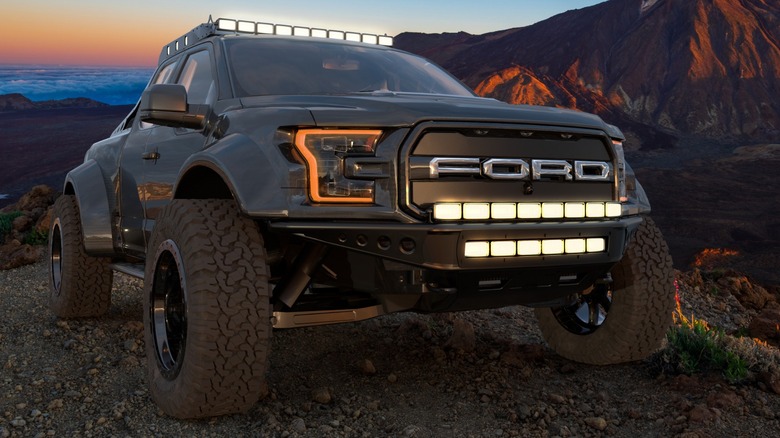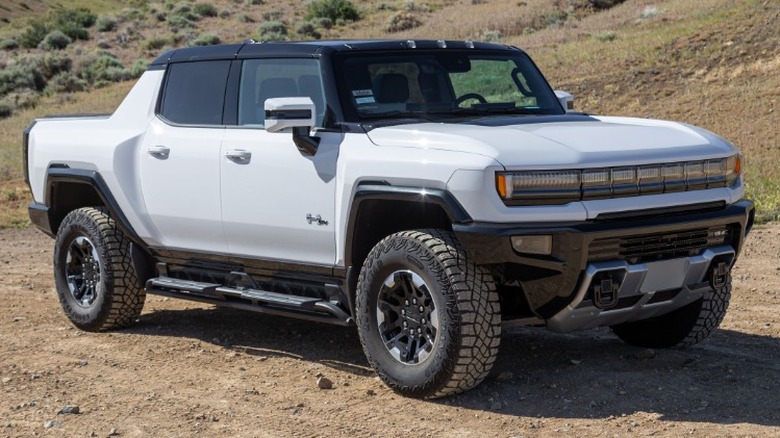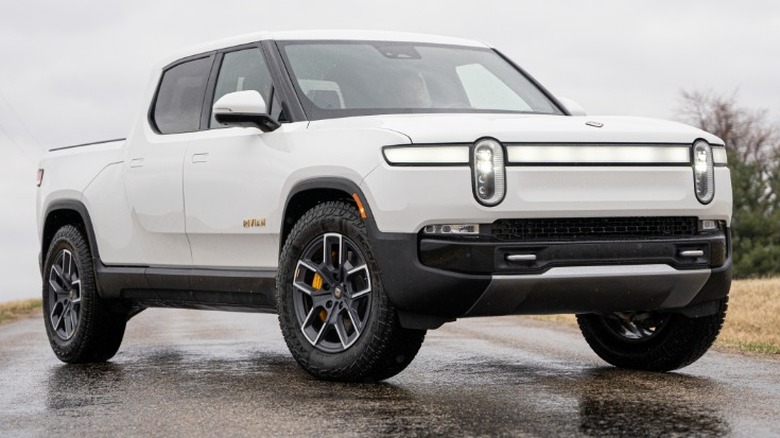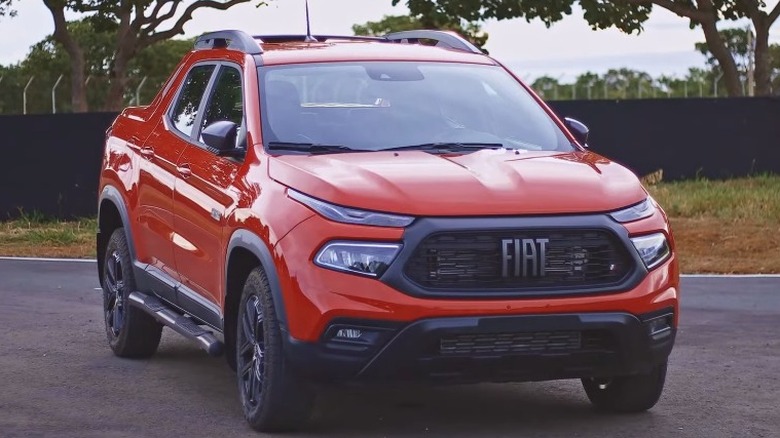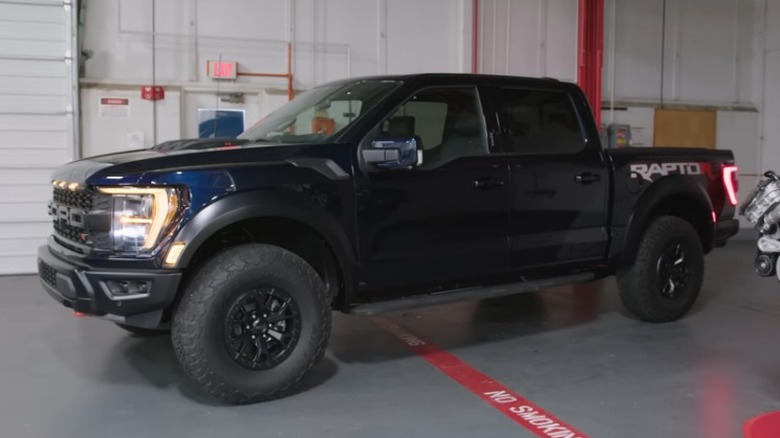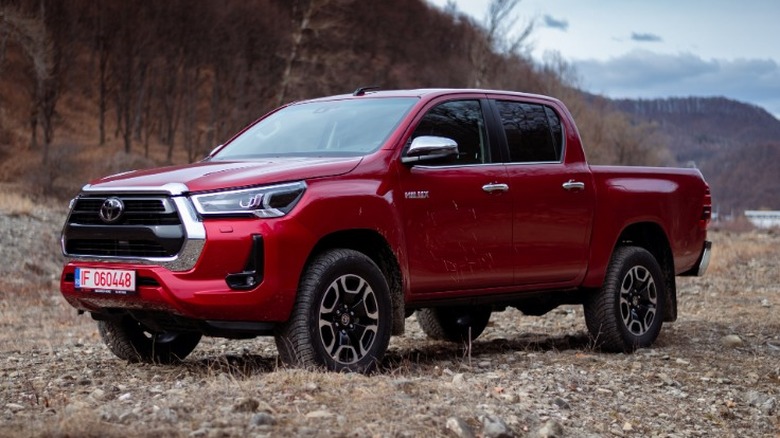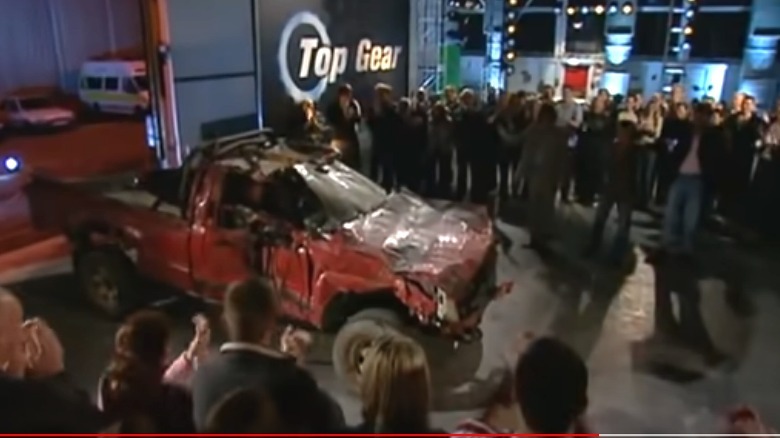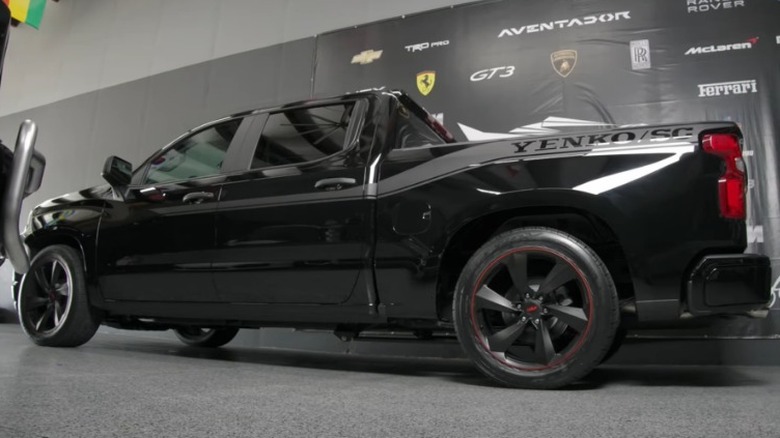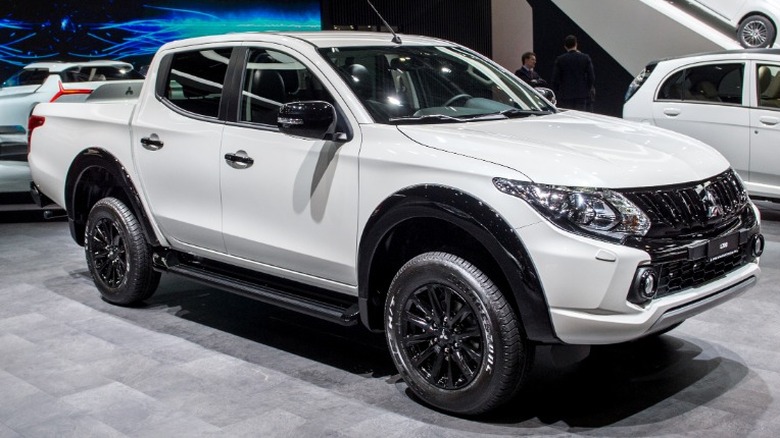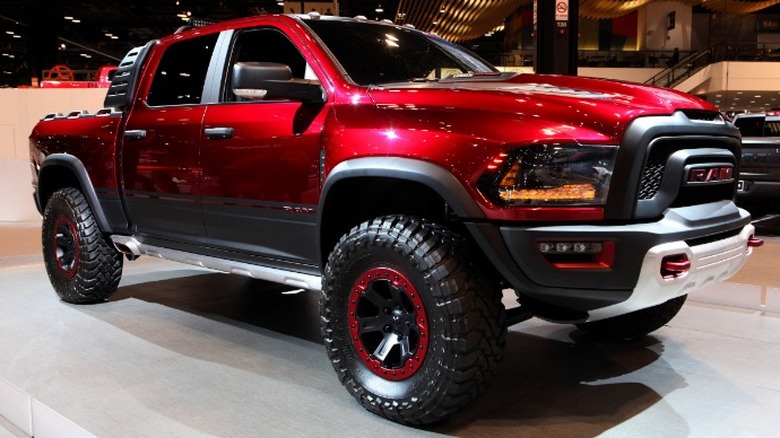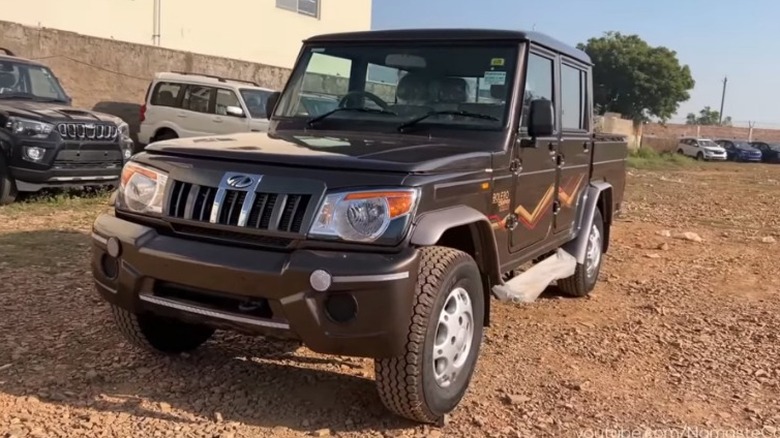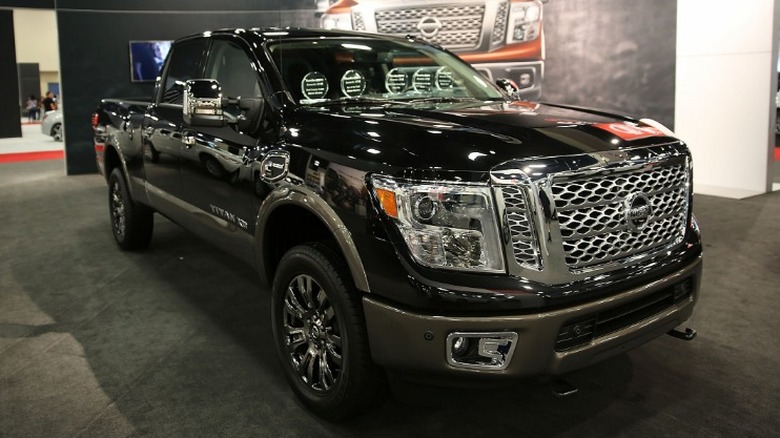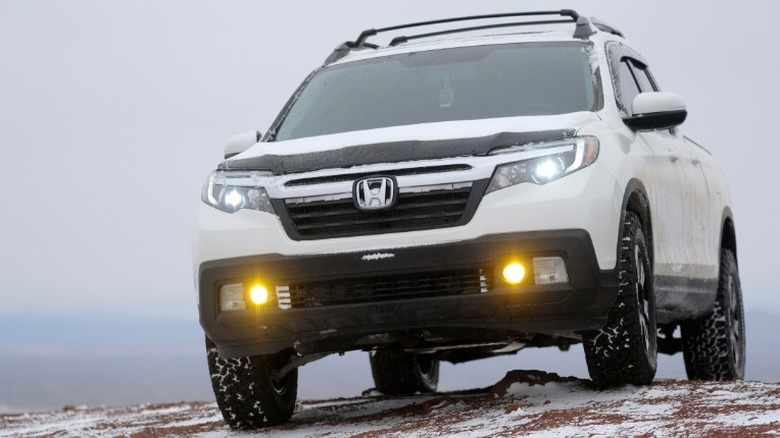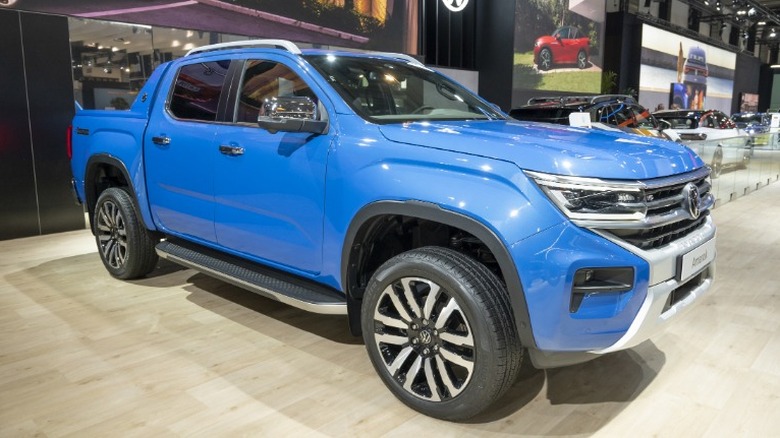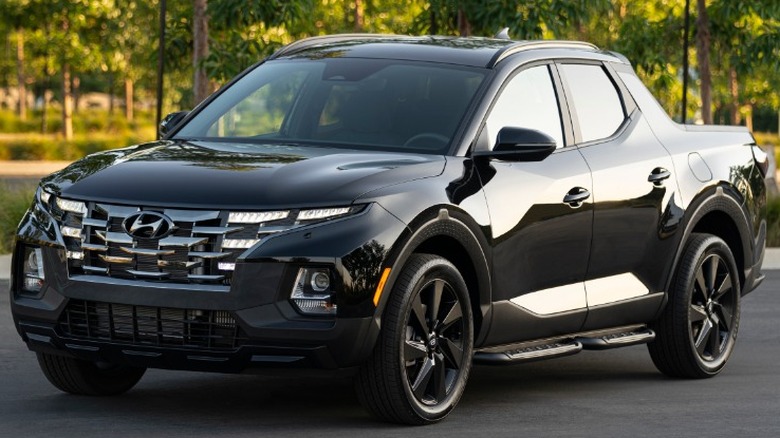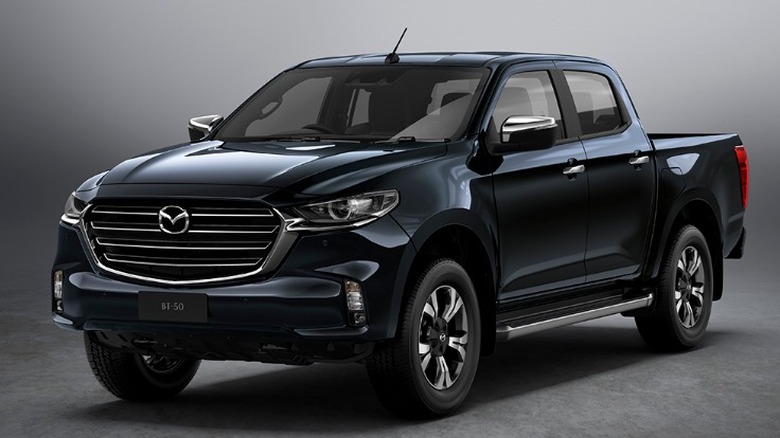The Best Pickup Truck From Every Major Brand
The mighty pickup truck is an icon of the American highway, and its efficacy as a tool used to facilitate work of all types is indisputable. For decades, trucks have been a symbol of the cowboy and the working man, but manufacturers have made changes over the last couple of decades to get trucks to appeal to a wider audience. Today, you are just as likely to find a pickup in the driveway of an attorney as a plumber. The modern conveniences and luxury features once reserved for cars are sometimes standard on trucks and often included in options packages, making it possible that a truck is every bit as plush and comfortable as a Cadillac.
Not every manufacturer produces a pickup, but the ones that do leave us with a wide variety to choose from. Large trucks dominate the American market, but pickups are still sold in countries around the world. Furthermore, there seems to be a truck for every buyer as the options are as varied as the customers. Trucks come in a wide variety of sizes and local customs — and terrain plays a big part in which ones will sell well in a particular territory. Taking a look at all the major manufacturers with vehicles for sale in any market, here are the best pickups from each of them.
GMC Hummer Pickup
GMC recently unveiled its all-electric Hummer SUT and sent it to dealers — and it will be followed up with an SUV soon, with production having started in early 2023. For reasons only known to GMC executives, SUT stands for sport utility truck, probably because we need more vehicle acronyms. Regardless of how silly the naming convention is, the Hummer impresses with extreme specifications and capabilities.
The first extreme to consider is the price of $87,000 to $110,000 for a fully trimmed model. For that chunk of change, you receive, depending on options, 1,000 horsepower of electric motivation that can carry you more than 300 miles on a single charge. With that kind of grunt, its towing capacity is rated up to 7,500 pounds, which is less generous than the Rivian or Ford Lightning, but few buyers of the Hummer are likely to have towing as a huge priority. Buyers of the Hummer want luxury features, which it delivers in spades.
Inside the Hummer, you will find a large screen powered by the Unreal Engine responsible for video game graphics along with dozens of other high-tech features, and underneath you will find extreme off-roading capability with fully adjustable suspension and 35-inch tires that can be turned to "crab walk" the vehicle. While on excursions off the highway, GMC has also equipped 35 cameras to gain points of view from nearly any angle, which might even help to get out of a jam. Initial reservations are sold out, so it may be a while before you can have your own.
Rivian R1T
Choosing the best truck from Rivian is easy as it was the only vehicle available from the automaker until August 2022, when the SUV version became available. Everything about Rivian and its R1T truck is unique and much of it is novel. While the truck is full of impressive features and its capabilities are above the bar, Rivian seems to have found a few things you didn't know you needed.
The Rivian provides 835 horsepower to all four wheels and can take you up to an estimated 400 miles on a single charge with the largest battery pack. But after you have depleted the available miles, charging from 10% to 80% takes just 30 minutes, making this EV capable and practical for real-world use. Inside the Rivian is a comfortable place to be thanks to its active air ride suspension and comfortable seats wrapped in soft vegan leather. Though the interior design is a bit conservative, it remains modern and fitting for the EV truck in which it is installed.
Rivian has supplied an advanced truck with ample features, but the extras really stand out. Chief among them is the pass-through tunnel behind the cab that adds protected storage, but the optional electric campout cooktop with integrated sink and running water takes the cake. Then, the removable Bluetooth speaker below the center console is a clever must-have as is the rechargeable Rolls-Royce umbrella-style flashlight in the door. Finally, the integrated tonneau cover, built-in air compressor, and multiple 120-volt power outlets round out the list of things we had no idea we needed. Perhaps this is saying we just need a Rivian.
Fiat Toro
Although Fiat is an unashamedly Italian company, it has operations the world over, including the United States. However, one of its most important markets is Brazil, which often contributes engineering and technology back to the parent company. As in so many international markets, pickups are used and viewed differently than in a place like Texas, for example. Yet, this is where one of Fiat's most clever models hails from, the Fiat Toro.
The Toro is a compact truck based on one of Fiat's small car platforms. Although small, it packs in a surprising amount of room for passengers and cargo while delivering excellent capabilities. The Toro is built upon the SCCS platform that is shared by the Jeep Compass and Jeep Renegade. This makes it a small car in North American terms, but globally, it is mid-size, and it's not even the smallest truck built by Fiat. Power comes from a turbo-diesel four-cylinder that offers drivers up to 170 horsepower and 258 pound-feet of torque, which should be plenty to haul almost anything that will fit in the bed, which is rated for up to 2,200 pounds.
The Toro looks as if it would be good competition to the new Ford Maverick as it is similar in size and capabilities. Residents in Latin America already appreciate it as the Ram 1000, but currently, there are no plans to bring it north of the Rio Grande.
F-150 Raptor R
A wise man once said "Faster is always better" — probably. Those who agree with that sentiment but still have a need to pick up bags of mulch for their landscaping might opt for the F-150 Raptor R for transportation. It is the latest in a line of Ford trucks to get a bit wild with the horsepower rating by people who think the F-150 is some kind of muscle car.
With the Raptor R, you get a full-size truck powered by a supercharged V8 –- a derivative of the engine in the Mustang Shelby GT500 that makes 760 horsepower — putting down 700 horsepower to all four corners. This truck is the kind of thing that engineers create not because they should, but because they can. It is blazingly fast and can shred sand dunes and back trails with aplomb while wrapping its occupants with a modern and supple interior space featuring Recaro seats and a large display right in the middle of the dashboard. Furthermore, the paint and styling of the truck are understated and perfect for the driver who wants to have loads of power without announcing it to everyone.
Although this truck can shred a quarter-mile on pavement or dirt, its hauling capacity is the lowest on the line. The max payload for a 2023 F-150 is 3,315 pounds with a tow rating of 13,000, but with the Raptor R package, those are reduced to 1,400 pounds and 8,700 pounds, respectively. But this truck was not expressly made for working. It was made simply because it was possible, although its price is north of $75,000.
Toyota Hilux
In the States, the Tundra or Tacoma may be the most popular Toyota truck, but elsewhere, the Hilux reigns supreme. The unkillable truck of "Top Gear" fame is still in production and continues as the vehicle of choice for people who need a rugged and utterly reliable truck worldwide. In the U.S., the Hilux was imported simply as Toyota Truck, with no model name printed anywhere on the vehicle, but it was replaced in 1998 with the Tacoma. Toyota continued on with the Hilux until today.
The Hilux continues on as a small truck, although it has gained rear seats and doors. Outside of the States, it is the world's best-selling pickup, and for good reason. Sales, at least in Europe, have been slipping as of late, and Toyota is trying to get customers back by adding more "carness" to its rugged workhorse by including comfort and luxury options, such as heated leather seats and a JBL audio system, not usually seen in a work beater. The engine options vary wildly from one continent to another, but it is safe to say that you can have a Hilux with a four-cylinder gas or diesel engine throughout. The largest is a 2.8-liter turbodiesel with just 201 horsepower but a stump-pulling 369 pound-feet of torque.
While we will never see a Hilux, thanks to an oppressive 25% tariff on light trucks that stems from a chicken export issue in the 1960s, we can still appreciate that it is, as always, the best of what Toyota has to offer.
Chevrolet Yenko/SC Silverado
The top-line Chevy truck is available only from official dealers, but it has been warmed over by Specialty Vehicle Engineering. Up to 800 horsepower makes the Yenko/SC the fastest and most powerful, and that obviously makes it the best. Chevrolet's competition has released some extremely powerful trucks, so Chevy just one-upped them with this Yenko/SC. The name is a tribute to the now-legendary extremely fast custom Corvairs and Camaros modified and sold by the Yenko Chevrolet dealership in the '60s and '70s.
To offer this very special truck, Chevy contracted Specialty Vehicle Engineering to beef up a Silverado with a number of modifications to the engine and suspension, with custom paint and graphics being added later. The supercharger adds power, but it is mated to an engine with CNC-ported heads on a blueprinted block running forged pistons and crankshaft. A lot of work has been done to this car to make it go fast, but Brembo brakes have also been installed to shut it down.
The Yenko/SC Silverado is a wild beast of a truck that can be purchased in an extreme off-road setup or one that has been lowered for the street. Although a third party performed the modifications, it is sold through Chevy dealers with the usual three-year/36,000-mile warranty like any other truck. However, you will need $79,995 or more, depending on options, for the opportunity to experience one.
Mitsubishi L200
When Japanese minitrucks first became hot items in the American market, Mitsubishi's models were sought after for their premium features and excellent build quality. The company held on for many years after its competitors left the market, finally withdrawing its small truck after the 1996 model year. Although Mitsubishi tried selling a rebadged Dodge Dakota as the Raider from 2006 to 2009 in the U.S., it continued building its small and dependable trucks to this day. The successor of the Mighty Max today is called the L200, and it retains what made its earlier trucks so desirable, but in a modern package.
The styling, size, and capabilities put the L200 in direct competition with the Ford Ranger and Toyota Hilux. Mitsubishi has long been known for its diesel engines, and that is the only choice for this truck: a 2.3-liter, four-cylinder with 148 horsepower and a healthy 295 pound-feet of torque. With that, you can tow up to 7,700 pounds of weight behind you while carrying five occupants comfortably. Furthermore, it comes with a trailer stability system, leather upholstery, heated front seats, a full-size spare, and more as standard equipment.
The L200 is a favorite in many countries where Mitsubishi still has a presence — it pulled out of the U.K., Ireland, and planned to leave Europe altogether in 2021, but has since scaled back some of those plans. Also, the L200 is its only pickup, so claiming to be its best was easy.
Ram 1500 TRX
Dodge has been treating us to some extravagantly powerful muscle cars lately with its Hellcat and Demon Chargers and Challengers, receiving many accolades for their performance. Not to be left out in the cold, truckmaker Ram has dipped into the collective parts bin and grabbed a supercharged V8 for itself. The 6.2-liter V8 chosen has been installed into the Ram 1500 TRX, and it comes packing 702 horsepower with 650 pound-feet of torque. And the naming of the truck is a bit of a tongue-in-cheek jab at Ford's Raptor high-powered truck, as the Tyrannosaurus Rex is the bigger and tougher dinosaur, hence the TRX name — this was not really the original idea behind the name, but Ram has since leaned into the idea.
With this expensive — more than $80,000 – half-ton, you will get lots of power along with 13 inches of travel, a reinforced steel frame, and huge 35-inch all-terrain tires. This is obviously meant to tear up the trails rather than the streets, however, it is tame on the roads and does not feel like the off-road brute that it is. The interior is much like other 1500 trucks, with cloth seats standard and leather upholstery optional, and the TR1 and TR2 packages bring up the refinement of the cabin significantly with luxury and convenience.
Truth be told, there are probably nicer Ram trucks available and there are definitely others that can get more work done — towing capacity is only 8,100 pounds — but this is the most powerful and the fastest, so that automatically makes it the best.
Mahindra Bolero Camper
Outside of the Indian subcontinent, most people will be unfamiliar with Mahindra trucks. The company has been selling tractors to American farmers since 1994 and sells domestically around half a million vehicles annually while employing 61,000 people. This company has been building trucks in India for many years and they are now ubiquitous on the roads of that country. Most of its products are for commercial purposes, but one truck is perfectly suited for consumer use: the Mahindra Bolero Camper.
At first glance, the Mahindra looks like something from a previous era, as it is lacking in the many sweeping curves and sharp creases typical of modern auto styling. Its styling is anything but modern, more resembling a box than anything. However, as it is built to withstand the rugged terrain and punishing undeveloped roads of the vast land of India, flashy styling is unnecessary. It is powered by a 2.5-liter diesel engine that only offers 75 horsepower and 143 pound-feet of torque, making it one of the least powerful new trucks available today. The interior is also very basic, offering few amenities and only two airbags with a very spartan interior.
While this truck appears dated, slow, and marginally unsafe, it is built in and for the Indian market. It performs well there and while it is lacking in features and capabilities, so too is the price of just $10,876. For about a third to a quarter of the price of a new truck in the U.S. or Europe, Indians can get a rugged and capable truck.
Nissan Titan
While Nissan began exporting its little trucks to the U.S. under the Datsun name along with the others in the '60s, domestic manufacturing eventually took hold and led Nissan to introduce its own full-size truck, the Titan. Built in America for American consumers, the Nissan Titan is competitive with anything from a domestic manufacturer. It was first introduced in 2004 and has been in the market ever since, undergoing only one major overhaul to the platform in 2016 and a styling refresh in 2020.
Nissan built this truck to compete directly with American trucks and the current model is built upon a full-size frame with a 5.6-liter gasoline V8 powering it. The Titan competes effectively with the American trucks, offering similar comfort, power, payload capacity, and options. A base Titan is priced at $5,000 more than an F-150 and offers similar capabilities, but only offers a 400-horsepower engine and its warranty is two years longer with an additional 64,000 miles of coverage. The additional warranty alone can make it worth the higher price. Plus, the base model Ford only has a 290-horsepower V6.
Nissan has been making trucks for nearly a century, starting with the Datsun 13 in 1934. The company has come a long way and built many trucks to sell worldwide, but the Titan is the biggest and most capable and, to some, might just be the best.
Honda Ridgeline
Choosing the best truck from Honda is another easy task as the company has only ever made a single model. Long known for its motorcycles, small engine equipment, and reliable and fuel-efficient cars, Honda has stayed away from the truck and heavy equipment market, but the market for pickups in the United States is large and provides ample opportunity for a manufacturer to gain sales. Therefore, Honda created the Ridgeline and sent it to dealers as a 2006 model. Major updates happened in 2009 and 2017, but production skipped the 2015 and 2016 model years. The Ridgeline is now integral to Honda's North American market and looks to continue that well into the future.
The Ridgeline differentiates itself from other trucks by being built on a monocoque chassis with front-wheel-drive. This gives it more car-like driving characteristics, but lowers its payload capacity. Owners generally don't mind the reduced abilities as they are not buying this truck for heavy work. The Ridgeline is for the consumer who wants the ability to haul stuff but prefers to drive cars. It sits in-between and has carved out its own niche, only recently being joined by the Ford Maverick and Hyundai Santa Cruz. Power comes from a 280-horsepower V6 through nine automatic gears, ending up at all four wheels in every model. The interior is done with typical Honda quality and thoughtfulness, resulting in a comfortable place to be, enhanced by a reputation for high reliability.
The Honda Ridgeline is perfect for those who don't like driving a truck but need at least some hauling capacity. This makes it a useful vehicle that is comfortable to live with on a daily basis for a specific group of buyers.
Volkswagen Amarok
Americans working in the Pennsylvania manufacturing operation of Volkswagen created the ever-popular Rabbit Pickup, but that truck is also the last time VW sold a pickup in the U.S. Consumer trucks have never been a big part of VW's operations, but the company has one on the market now which shares some engineering with the current Ford Ranger, and it is called the Amarok.
The first Amarok went on sale as a 2010 model with all Volkswagen engineering going into its unibody construction and engine options. It was praised for having good handling and a comfortable ride. However, mediocre sales forced VW to make some changes, which resulted in a Ford partnership to revise the mid-size truck for the 2022 model year – production shut down altogether in 2020 and skipped a couple of years. It returned with a body-on-frame chassis, new engines, a live axle on leaf springs, and a larger footprint. The new truck may have lost some of its car-like handling, but gained more hauling and towing capability. Furthermore, it also lost some of its VW-like characteristics, and that is because it shares most of its engineering with the Ford Ranger.
The Amarok is an attractive truck that you won't be buying from any American dealer, as it is built in South Africa and would be subject to a 25% tariff. However, that matters not, because you can still buy an American-built Ford Ranger and essentially get the same great truck.
Hyundai Santa Cruz
Hyundai has been building cars for export to the U.S. as well as building cars in the U.S. for decades now, but all of them so far have been passenger vehicles. That changed when the company debuted its Santa Cruz for the 2022 model year. Although this would be the first consumer-grade truck from the company, it does not stray far from its passenger car roots.
The Santa Cruz is a small truck built atop a unibody chassis similar to the company's small SUV platforms. It seats five and has four doors with a small but useful bed. With a cargo volume of 27 cubic feet, it offers about half of what a Ford F-150 does. Powered by a four-cylinder engine, the Santa Cruz will never be a serious work truck, but it will provide economical commuting with the ability to pick up a set of end tables on the way home. You can get a Santa Cruz with or without turbo and either two or four-wheel-drive, the latter of which would be great for mountain dwellers.
The Santa Cruz is another niche model that includes the Ford Maverick and not much more as its competition. The cabin is typical Hyundai throughout, which is not to say that is a bad thing — Hyundai fit and finish has come a long way since 1986. For someone who collects antiques or does light landscaping, the Santa Cruz is a good choice, and the excellent five-year/60,000-mile warranty makes it even more compelling.
Mazda BT-50
Mazda trucks were favorites of the Japanese truck imports back in the '70s and '80s when they showed up as Mazda models as well as the Ford Courier. While Ford later created its Ranger, Mazda continued selling its trucks until it became untenable and, in a twist, started selling Ford Rangers as its own. Like all the other Japanese trucks, the chicken tax killed all prospects for having further imported Mazda truck models in America, but everyone else can enjoy them.
Mazda no longer partners with Ford to manufacture its small trucks, but its current model, the BT-50, was developed jointly with Isuzu, which also no longer sells consumer trucks in the U.S. Like many small trucks sold in other markets, the only engine options for the BT-50 are diesel. Both engines are turbodiesels and are offered with a displacement of either 1.9 or 3.0 liters. Styling is congruent to other Mazda models — from the front doors forward, the BT-50 could be mistaken for a CX-9 SUV. However, that applies only to the exterior as the CX-9 is distinctly upmarket inside and the BT-50 interior is comparable to other small trucks, although it retains Mazda's typically excellent fit and finish.
Although this Mazda would be an excellent alternative to a full-size truck or even something like the Ford Ranger, we cannot have it on American shores. Mazda's primary markets for the BT-50 include Southeast Asia and Oceania. For any Aussies reading this, here's a possible choice for your next truck — or, in Australian parlance, ute.
